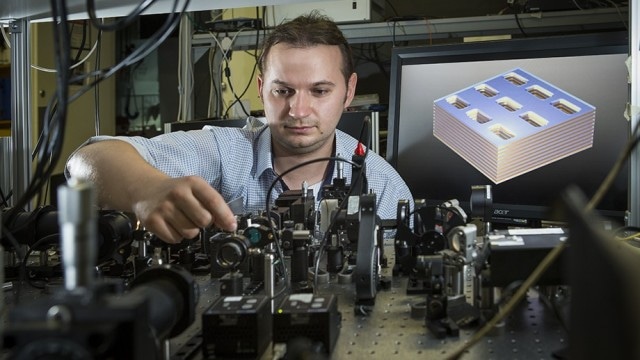Apr 19 2016
Radical new properties present in a nanomaterial have been discovered by physicists. This discovery provides the potential to develop greatly efficient thermophotovoltaic cells, which in the future will be able to harvest heat in the dark and then convert it into electricity.
 Dr Kruk next to a diagram of the metamaterial structure. (Credit: Image Stuart Hay, ANU)
Dr Kruk next to a diagram of the metamaterial structure. (Credit: Image Stuart Hay, ANU)
The team of researchers from the University of California Berkeley and the Australian National University (ARC Centre of Excellence CUDOS) have illustrated a new metamaterial, or artificial material, capable of glowing in a unique way when heated.
These findings could help to develop cells that transform radiated heat into electricity. These cells are known as thermophotovoltaic cells.
Thermophotovoltaic cells have the potential to be much more efficient than solar cells. Our metamaterial overcomes several obstacles and could help to unlock the potential of thermophotovoltaic cells.
Dr Sergey Kruk from, Research School of Physics and Engineering, ANU
Compared to standard solar cells, thermophotovoltaic cells are a lot more efficient. Thermophotovoltaic cells do not depend on direct sunlight to produce energy, instead they harvest heat in the form of infrared radiation from their surroundings.
Thermophotovoltaic cells can also be merged with the help of a burner in order to form on-demand power, or can also recycle heat discharged by hot engines.
The research is featured in Nature Communications.
The metamaterial used by the researchers help to radiate heat in a particular direction. This material is made up of very small nanoscopic structures of magnesium fluoride and gold. It is also possible to adjust the metamaterial’s geometry to give out radiation in a particular spectral range, in contrast to conventional materials that give off heat in all directions as a wide range of infrared wavelengths. This allows the metamaterial to be used as an emitter, paired with a thermophotovoltaic cell.
The project commenced when Dr Kruk suggested that the newly developed metamaterial would contain these unexpected properties. The ANU team then collaborated with scientists from the University of California Berkeley. These scientists have unique skills to develop such materials.
To fabricate this material the Berkeley team were operating at the cutting edge of technological possibilities. The size of individual building block of the metamaterial is so small that we could fit more than twelve thousand of them on the cross-section of a human hair.
Dr Sergey Kruk from, Research School of Physics and Engineering, ANU
The metamaterial is known for its exceptional behavior due to its unique physical property of magnetic hyperbolic dispersion. Dispersion refers to how light interacts with materials, and it can be viewed as a three-dimensional surface representing the propagation of electromagnetic radiation in varied directions. For natural materials, like crystals or glass, the dispersion surfaces contain simple forms, ellipsoidal or spherical.
The new metamaterial’s dispersion takes a hyperbolic form and is very different. This is due to the material’s strong interactions with the magnetic component of light.
It is possible to enhance the competence of thermovoltaic cells based on the metamaterial, if a nanoscopic gap is present between the receiver and the emitter. In this configuration, radiative heat can be transferred between them for more than ten times in an efficient manner, compared to the standard materials.